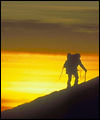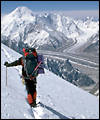

SEE ALSO
Greenland '99
Denali '99
Ed Viesturs
Climbs 8K Peaks
Everest '99
Everest Archives


Editor's Note: September 13, 1999: MountainZone.com has just learned that American Steve Swenson's expedition to Gasherbrum IV did not summit. A defunct satellite phone has prevented them from checking in, but sources in Pakistan report that all members of the team are fine, and should be back in the States this week. More details to follow.
Latest News
Hushe Valley, Pakistan: August 25, 1999
"K2 Base Camp, known as "the Strip," is vacant. The Baltoro Glacier is almost
devoid of climbers, but don't turn out the lights yet because the best show
in town is still around..."
[Click for the Latest Dispatch]
Greg Mortenson of the Central Asia Institute will provide MountainZone.com with climbing updates and dispatches from the Karakoram Range all summer long. Tommy Heinrich, who was to report on his attempt on K2, shifted his efforts to Broad Peak following the death of his climbing companion.
Want to climb the Karakoram?
You'll have to get there first!
 K2 at Dawn |
In 1958, Fosco Mariani, the great Italian climber described the Karakoram as the "World's Greatest Museum in Shape and Form." The crown jewel of the Karakoram is K2 (8,611 meters), the world's second highest peak. K2's imposing granite pyramid contains enough mass to fill over 80 Matterhorns. Many mountaineers consider K2 the most difficult and dangerous 8,000 meter peak to climb.
Karakoram peaks have nicknames that evoke fear and passion: "Savage Mountain" for K2, "Killer Mountain" for Nanga Parbat (8,125 meters) "Shining Wall" for Gasherbrum IV (7,929 meters) and "Bride's Peak" for Chogolisa (7,665 meters), which is the feminine analog for Chogori, K2, its neighbor and wife in local folklore.
The Karakoram's indigenous Balti people first migrated to Baltistan, in northeast Pakistan, 600 to 800 years ago from Tibet. While the Baltis share a common ancestry and language with the Himalaya Sherpas, the similarities stop there.
The Islamic Moghul insurgence of the 1500s wiped out Buddhism in northern Pakistan. There are no teahouses. No alcohol. No Islamic pork-forbidden strings of salami. No roofs lined with TV satellite discs. No Rin-Tin-Tin T-shirts. What there are everywhere are dramatic mountains, endless cups of sweet Chai and the habitual evening "Hazzan," the haunting, melodic Islamic call to prayer.
There are infinite opportunities for 8,000 meter climbs, first ascents and magnificent treks in the Karakoram, but only about 1500 climbers and trekkers visit the region annually. I often wonder why. Perhaps because the region is 99% Muslim. Perhaps because the Karakoram does not have Everest. Perhaps because Pakistan and India are lobbing artillery shells nearby. Perhaps because the area is so inaccessible.
| "The 58-mile Baltoro Glacier trek to the central Karakoram is not easy. Occasionally, the grueling week-long Baltoro hike even stops elite climbers dead in their tracks..." |
But for those who enter the "Throne of the Mountain Gods," (Galen Rowell book), the journey of a lifetime awaits them. Half of the challenge in the Karakoram is just to get to base camp. Often, sweltering 100°F temperatures greet climbers when they hit Islamabad airport at dawn. Then, with luck and good weather, a 50-minute Boeing 727 flight over Nanga Parbat's dominant massif drops climbers in Skardu, at the Karakoram's doorstep. But for others, the journey from Islamabad to Skardu is a 24-hour epic in a dilapidated, but colorful Bedford bus. There is no sleep as it grinds over the tortuous Karakoram highway to the blast of Urdu lovesongs and smell of thick diesel fumes dancing in the sky.
In Skardu, climbers squeeze in crammed 4WD Toyota jeeps to Askole Village. The Askole road is a eight-hour test of steel nerves on a careening and precarious jeep trail. A split-second, or one-foot, mistake drops the overloaded jeep to its demise in the roaring Braldu River below. Here, even atheists join their Muslim driver in prayer for protection from Almighty Allah for a safe journey.
The jeep trail stops in Askole Village. A frenzied mass of porters gathers amidst swirls of dust and shouts to vie for lucrative, but illusive, jobs hauling massive expedition loads to base camp. Meanwhile, in nearby Balti villages, already overburdened women must double their workload due to a lack of "manpower." The porter's scuffle ends when a chain of porters chant "Allah Akbhar" and heads off to the mountains with their golden 25kg. payloads.
The 58-mile Baltoro Glacier trek to the central Karakoram is not easy. Occasionally, the grueling week-long Baltoro hike even stops elite climbers dead in their tracks, turning them home before they arrive at Base Camp. Every kind of weather is imaginable: scorching heat, stinging sandstorms and blinding blizzards. There is no need for a toothbrush as the Baltoro Glacier water's silt grits away tooth plaque.
With each day, new peaks appear along the Baltoro corridor. Paiyu "Salt" Peak, Cathedral Spires, Great Trango Tower, Masherbrum, Muztagh Tower. But the 8,000 meter giants wait until last — K2, Broad Peak and Gasherbrum I and II.
 Concordia, from Broad Peak |
Broad Peak's imposing three summits look like gigantic roller coasters in the northeast. Gasherbrum IV looms 10,000 feet above, a two-hour walk to the east. Chogori's elegant crest rises in the southeast. Mitre Peak (6,025 meters) looks like a twisted skewer piercing the sky in the south. In the west, the Baltoro Glacier's narrow corridor forms the entrance to what Galen Rowell calls, "The Throne of The Mountain Gods."
Concordia's view is a perfect reward for those that make it there. I have been to Concordia every year since 1993, from May to December. Even if I went there one hundred times, I would not tire of its magnificence.
When I arrive at Concordia, I imagine myself sitting in a giant hall listening to the strains of a colossal symphony. And in the evening, when alpenglow climbs up GIV's "Shining Wall," the symphony ends with a lone porter's solo encore of the "Hazzan." Nothing could be more perfect.
For climbers, the task has yet to begin.
— Greg Mortenson, MountainZone.com Correspondent
Mortenson, director of the Central Asia Institute, lives in the
Karakoram for six months each year, and has done so since a 1993 climb
of K2. He is the only foreigner working in the K2 region with local
Balti villagers to help develop community based education, conservation
and women's projects. In 1998, Greg was awarded
the American Alpine Club's prestigious David Brower Conservation Award
for the work done by the Central Asia Institute.